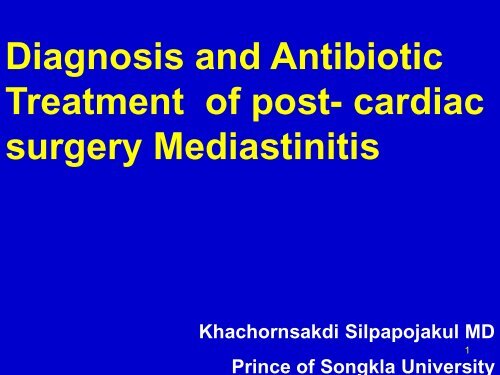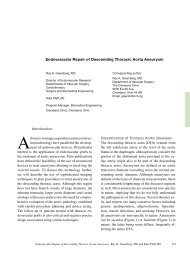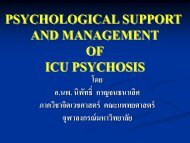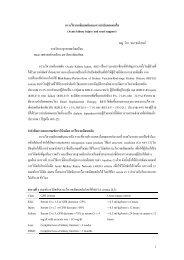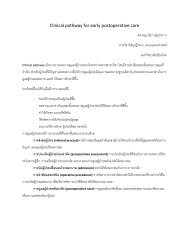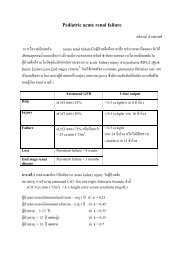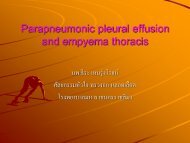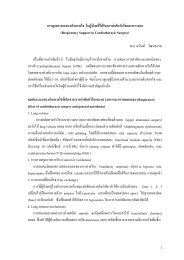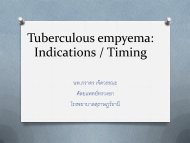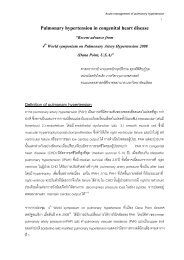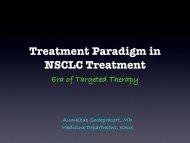Diagnosis and Antibiotic Treatment of post-cardiac surgery ...
Diagnosis and Antibiotic Treatment of post-cardiac surgery ...
Diagnosis and Antibiotic Treatment of post-cardiac surgery ...
You also want an ePaper? Increase the reach of your titles
YUMPU automatically turns print PDFs into web optimized ePapers that Google loves.
http://www.cdc.gov/nhsn/pdfs/pscmanual/17pscnosinfdef_current.pdf
El Oakley <strong>and</strong> Wright Classification <strong>of</strong>mediastinitis
Jones Classification <strong>of</strong> mediansternotomy wounds
Jones Classification <strong>of</strong> mediansternotomy wounds
“ The diagnosis <strong>of</strong> mediastinitis ischaracterized by the association <strong>of</strong>sternal instability <strong>and</strong> the presence<strong>of</strong> retrosternal purulent fluidcollection.” Levi N, Olsen PS. Primary closure <strong>of</strong> deepsternal wound infection following open heart <strong>surgery</strong>: a safeoperation? J Cardiovasc Surg. 2000;41(2):241-5.
Why?
PSU Deep Sternal WoundInfections: How Many?
ปีงบฯ2551ปีงบฯ2552ปีงบฯ2553ปีงบฯ2554 ปีงบฯ 2555ProcedureSIR SIR SIR SIR SIR(เท่า)Open Heart<strong>surgery</strong> 0.86 0.62 0.51 1.24 0.27CABG # # # # 0.73Cholecystectomy 6.27 3.79 5.15 2.47 3.65Colectomy 0.73 1.00 0.57 0.60 0.26Craniotomy 5.14 3.93 2.83 4.28 3.66Mastectomy 1.23 1.24 0.37 0.43 1.03Total 1.98 1.63 1.31 1.53 1.09
August 2001 - January 200816 (0.82%.) <strong>of</strong> 1954 adult patientsundergoing <strong>cardiac</strong> <strong>surgery</strong> were diagnosedwith deep sternal wound infection
Ann Thorac Surg 2000;69:1104 –9The incidence <strong>of</strong> deep sternalinfections in this series was 0.9%(33 patients)
Ottawa University Heart Institute (1990-1992)Superficial sternal wound infection = 78/3200patients (2.5%)Deep sternal wound infection wound infectionoccurred in 12 patients (0.37% ).
When?
The median time from the primary<strong>cardiac</strong> operation to the diagnosis<strong>of</strong> DSWI = 6 days (range, 3–16 d.)
Ann Thorac Surg 2000;69:1104 –9The median interval betweenoperation <strong>and</strong> intervention due toinfection was 48 days (4 to 270).
How? Dx?
Clinical Presentations?
A Brazilian study between 2007- 200925 (2.4%) <strong>of</strong> 1038 patients developedmediastinitis
The mean time <strong>of</strong> mediastinitisappearance was 13.1 ± 7.2 days(range from 5 - 35 days).The most frequent complaint wasretrosternal pain (92%; n=23).
“…..patient themselves will typicallyreport sternal clicking withinspiration, cough, or various otherphysical maneuvers. ”
How? CXR Dx?
http://www.cdc.gov/nhsn/pdfs/pscmanual/17pscnosinfdef_current.pdf
3. Patient has at least 1 <strong>of</strong> the following :Fever (>38°C), chest pain, or sternalinstability (with no other recognized cause )<strong>and</strong> at least 1 <strong>of</strong> the following:a. purulent discharge from mediastinal areab. organisms cultured from blood ordischarge from mediastinal areac. mediastinal widening on imaging test.
Limited value <strong>of</strong> plain CXR filmMediastinal widening : ? <strong>post</strong>operativehemorrhage <strong>and</strong> edemaSternal separation:.? Normal <strong>post</strong>sternotomy change < 4-8 mm?
CT.Dx?
“ The diagnosis <strong>of</strong> mediastinitis ischaracterized by the association <strong>of</strong>sternal instability <strong>and</strong> the presence<strong>of</strong> retrosternal purulent fluidcollection.” Levi N, Olsen PS. Primary closure <strong>of</strong> deepsternal wound infection following open heart <strong>surgery</strong>: a safeoperation? J Cardiovasc Surg. 2000;41(2):241-5.
A retrosternalfluid <strong>and</strong> gascollectionSubcufluid <strong>and</strong>gasollectionMediastinitis
Free gas bubble<strong>and</strong> retrosternalfluid collectionMediastinitis
Air bubble &large fluidcollectuinNo mediastinitis
NB: Late group = > 21 days after<strong>surgery</strong>
Days after<strong>surgery</strong>SensitivitySpecificity=/< 21 days 100% 39%> 21 days 100% 85%
A normal CTscan rapidly rules outsignificant retrosternal pathology.
J Thorac Cardiovasc Surg 2003;125:611-7
Case 1• A 73-year-old man• ASD secundum S/P ASD closure 30/7/56• Presented with sternal wound pain <strong>and</strong> rednesswithout discharge 1 month after <strong>surgery</strong>• He took oral clindamycin 1200 mg/day 2 daysbut it was not improved• No constitutional symptoms, no fever, nocough
Case 1• CT chest (for work up mediastinitis)– Surgical site infection with suspected a smallfluid 7x13 mm in retrosternal region– Minimal pericardial effusion, 6.5 mm thick aswell as minimal bilateral pleural effusion, 3.2mm thick Rt <strong>and</strong> 4.2 mm thick Lt– A 2.7 mm pleural based nodule in anteriorsegment <strong>of</strong> RLL– Minimal reticul<strong>of</strong>ibrosis in bilateral basal lungs
Case 1• Pus AFB : positive 2+• Pus mAFB : negative• Pus C/S TB : pending• Pus PCR TB : pending• Pus C/S aerobe : no growth
Which Organisms?
Five tissue samples for direct agarplate culturing.Interpretation <strong>of</strong> positive causativebacteria = the finding <strong>of</strong> the samespecies in at least half <strong>of</strong> the samples
Ottawa University Heart Institute (1990-1992)
Ann Thorac Surg 2000;69:1104 –9
A Brazilian study between 2007- 200925 (2.4%) <strong>of</strong> 1038 patients developedmediastinitis
0.8% (52 <strong>of</strong> 6492 patients) had sternalwound infection,
The culture was positive in40 patients(81.6%)Pseudomonas aeruginosa =17 (36.7%)Staphylococcus spp = 11 (22.4%),Streptococcus species = 7 (14.3%),E. coli = 3 (6.1%),Mycobacterium tuberculosis =2 (4.1%),
High body mass index <strong>and</strong> COPDwere significantly associated withcoagulase negative staphylococci(P
Patients who had been reoperatedbefore onset <strong>of</strong> mediastinitis tended tohave an increased risk for a gramnegativeetiology (32 vs. 15% inpatients not reoperated, P = 0:06).
MRSA = 8/14MSSA = 3/14Pseudomonas aeruginosa = 3/14And one each <strong>of</strong> Acinetobacterbaumanii, Morganella morganii,Enterobacter
How? Rx?
MRSA = 8/14MSSA = 3/14Pseudomonas aeruginosa = 3/14And one each <strong>of</strong> Acinetobacterbaumanii, Morganella morganii,Enterobacter
Ann Thorac Surg 2000;69:1104 –9The incidence <strong>of</strong> deep sternalinfections in this series was 0.9%(33 patients)
Vancomycin + piperacillin-tazobactam orvancomycin + ceftazidime orvancomycin + fluoroquinoloneBr<strong>and</strong>ler ES et al. Mediastinitis in Emergency Medicine Medication
<strong>Antibiotic</strong> Rx:How long?
Targeted antibiotic therapyfor 4-6 weeks duration.Atkins BZ, et al.. Does method<strong>of</strong> sternal repair influence long-termoutcome <strong>of</strong> <strong>post</strong>operative mediastinitis? Am J Surg 2011.Sjogren J, et al. Poststernotomy mediastinitis: areview <strong>of</strong>conventional srugical treatments, vacuum-assisted closuretherapy <strong>and</strong>presentation <strong>of</strong> the Lund University Hospitalmediastinitis algorithm. Eur JCardiothorac Surg 2006; 30: 898-905.
August 2001 - January 200816 (0.82%.) <strong>of</strong> 1954 adult patientsundergoing <strong>cardiac</strong> <strong>surgery</strong> were diagnosedwith deep sternal wound infection
Deaths = 0 upon follow-up <strong>of</strong>26– 92 months.Median length <strong>of</strong> <strong>post</strong>operativeICU stay= 4 days (range, 1–9days)Median length <strong>of</strong> hospital stay =23.5 days (range, 19–36 days),
How? Prevention?
Surgical Wound Infections:Factors1.Patients2.Surgical Team3.Operating Room & Equipment
Diabetes MellitusThe contribution <strong>of</strong> diabetes to SSI risk is controversial,although increased glucose levels (>200 mg/dL) in theimmediate <strong>post</strong>operative period (48 hours) were associatedwith increased SWI risk.“Adequately control serum blood glucose levels inalldiabetic patients <strong>and</strong> particularly avoidhyperglycemia perioperatively.” CDC Category IBSuggestion.
Cigarrette SmokingNicotine use delays primary wound healing <strong>and</strong> may increasethe risk <strong>of</strong> SSI. In a large prospective study, current cigarettesmoking was an independent risk factor for sternal <strong>and</strong>/ormediastinal SSI following <strong>cardiac</strong> <strong>surgery</strong>.Nagachinta T et al. Risk factors for surgical-woundinfection following <strong>cardiac</strong> <strong>surgery</strong>. J Infect Dis 1987; 156:967-73.
Cigarrette SmokingEncourage tobacco cessation. At minimum, instructpatients to abstain for at least 30 days before electiveoperation from smoking cigarettes.CDC: Guideline for Prevention <strong>of</strong> Surgical Site Infection,1999. AJIC 1999;27:97
Preoperative Hospital StayKeep preoperative hospital stay as short aspossible while allowing for adequatepreoperative preparation <strong>of</strong> the patient.CDC’s Category II Suggestion.AJIC 1999;27;97
Nasal Staphylococcus aureus colonization?A recent multivariate analysis demonstrated that S.aureus nasal carriage was the most powerfulindependent risk factor for SSI followingcardiothoracic operations.Kluytmans JA et al. Nasal carriage <strong>of</strong> Staphylococcus aureusas a major risk factor for wound infections after <strong>cardiac</strong><strong>surgery</strong>. J Infect Dis 1995;171:216-9.
Decolonization <strong>of</strong> nasal Staphylococcus aureus?In one study, SSI rates for 752 mupirocin-treated patientswere compared with those previously observed for anuntreated group <strong>of</strong> 928 historical control patients, <strong>and</strong> thesignificant SSI rate reduction was attributed to themupirocin treatment.Ref.: Kluytmans JA, et al. Reduction <strong>of</strong> surgical-siteinfections in cardiothoracic <strong>surgery</strong> by elimination <strong>of</strong> nasalcarriage <strong>of</strong> Staphylococcus aureus. Infect Control HospEpidemiol 1996;17:780-5.
INTRANASAL MUPIROCIN TO PREVENTPOSTOPERATIVE STAPH. AUREUSINFECTIONS:Perl TM et al. NEJM 2002;346:1871-7R<strong>and</strong>omized, double-blind, placebo-controlled trial todetermine whether intranasal Rx with mupirocin (BID.x 5days before <strong>surgery</strong>) reduces the rate <strong>of</strong> S. aureusinfectionsat surgical sites <strong>and</strong> prevents other nosocomial infections.
INTRANASAL MUPIROCIN TO PREVENTPOSTOPERATIVE STAPH. AUREUSINFECTIONS:Perl TM et al. NEJM 2002;346:1871-7Results:Overall, nasal carriage <strong>of</strong> S. aureus waseliminated in 83.4 %<strong>of</strong> patients who receivedmupirocin, as compared with 27.4 % <strong>of</strong> patientswho received placebo (P
INTRANASAL MUPIROCIN TO PREVENTPOSTOPERATIVE STAPH. AUREUSINFECTIONS:Perl TM et al. NEJM 2002;346:1871-7Results: Among the patients with nasal carriage <strong>of</strong> S.aureus,4.0 %<strong>of</strong> those who received mupirocin hadnosocomial S. aureus infections, as compared with7.7 %<strong>of</strong> those who received placebo (odds ratio forinfection, 0.49; 95 percent confidence interval, 0.25to 0.92; P=0.02).Only 6 <strong>of</strong> 1021 S. aureus isolates (0.6 %),obtained from six patients, were resistant tomupirocin during the four-year study period.
Decolonization <strong>of</strong> nasal Staphylococcus aureus?No recommendation to preoperatively applymupirocin to nares to prevent SSI. Unresolved issueCDC: Guideline for Prevention <strong>of</strong> Surgical Site Infection,1999. AJIC 1999;27:97
Preoperative antiseptic showering?A study <strong>of</strong> >700 patients who received preoperativeantiseptic showers showed that chlorhexidinereduced bacterial colony counts ninefold. However,,they have not definitively been shown to reduce SSIrates.Rotter MLet al. A comparison <strong>of</strong> the effects <strong>of</strong> preoperative wholebodybathingwith detergent alone <strong>and</strong> with detergentcontainingchlorhexidine gluconate on the frequency <strong>of</strong> woundinfectionsafter clean <strong>surgery</strong>. The European Working Party on Control<strong>of</strong> Hospital Infections. J Hosp Infect 1988;11:310-20.
Preoperative antiseptic showering?Require patients to shower or bathe with an antisepticagent on at least the night before the operative day.CDC’s Category IB Suggestion. Guideline for Prevention <strong>of</strong>Surgical Site Infection, 1999. AJIC 1999;27:97
Preoperative hair removal?Type <strong>of</strong> hair removal Surgical infection rateShaving 5.6%Depilation 0.6%No hair removal 0.6%Seropian R, Reynolds BM. Wound infections afterpreoperative depilatory versus razor preparation. Am J Surg1971;121:251-4.
Nonshaved cranial neuro<strong>surgery</strong>.Ratanalert S.et al. Surg Neurol. 1999;51(4):458-63No.Surgical infection rateShaved 136 5.9%Non shaved 89 3.3% ( P= NS)
Preoperative Skin Shaving Practices inSongklanagarind Hospital.WardOrthopedicObstetric <strong>and</strong> gynecologySurgery <strong>and</strong> ENTFrequency <strong>of</strong> shavingNever shave for at least 10 yearsRoutinely performedDiversity <strong>of</strong> practicesSource : Silom Jamulitrat et al.
Type <strong>of</strong> <strong>surgery</strong>NumberShaveperformedPercentageDigestive system <strong>surgery</strong> 43 28 65.1%Cardiovascular <strong>surgery</strong> 18 15 83.3%Integumentary <strong>surgery</strong> 15 9 60.0%Cranial <strong>surgery</strong> 9 5 55.6%Source : Silom Jamulitrat et al.
Musculoskeletal<strong>surgery</strong> 9 5 55.6%Thyroid <strong>surgery</strong> 7 2 28.6%Urinary system<strong>surgery</strong> 6 6 100.0%Salivary gl<strong>and</strong><strong>surgery</strong> 3 1 33.3%Source : Silom Jamulitrat et al.
Preoperative hair removal?Do not remove hair preoperatively unless the hair at or aroundthe incision site will interfere with the operation.If hair isremoved, remove immediately before the operation, preferablywith electric clippers. CDC’sCategory IA Suggestion.Guideline for Prevention <strong>of</strong> Surgical Site Infection, 1999.AJIC 1999;27:97
Distribution <strong>of</strong> time interval between skin shaving<strong>and</strong> operation performed, PSU Hospital.Time interval Number Percentageno record 60 81.1%< 2 hr 2 2.7%between 2 <strong>and</strong> 12hours 2 2.7%more than 12 hr 10 13.5%total 74 100.0%Source : Silom Jamulitrat et al.
Preoperative <strong>Antibiotic</strong>Quantitatively, it has been shown that if a surgical site iscontaminated with >10 5 microorganisms per gram <strong>of</strong> tissue,the risk <strong>of</strong> SSI is markedly increased. Preoperative antibioticprophylaxis is not an attempt to sterilize tissues, but acritically timed adjunct used to reduce the microbial burden <strong>of</strong>intraoperative contamination to a level that cannot overwhelmhost defenses. It is indicated for all operations that entailentry into a hollow viscus (clean contaminated wound) <strong>and</strong>is sometimes indicated for clean operations when anyprosthetic material or a prosthetic joint will be inserted, <strong>and</strong>(2) for any operation in which an incisional or organ/spaceSSI would pose catastrophic risk.
The recommended prophylaxisfor <strong>cardiac</strong> procedures isCefazolin or Cefuroxime.
? Vancomycin prophylaxis???
“ The use <strong>of</strong> vancomycin as prophylaxis isdiscouraged because <strong>of</strong> the risk <strong>of</strong> selection<strong>of</strong> resistant bacteria, with subsequentecological <strong>and</strong> therapeutic consequence.Furthermore, vancomycin is intrinsically aless active antistaphylococcal agent thanare beta-lactam antibiotics.
Clinical Infectious Diseases 2004; 38:1357–63
Preoperative <strong>Antibiotic</strong>: When?Basic “rules <strong>of</strong> thumb” guide decisions about antibioticdose sizes <strong>and</strong> timing. For example, it is believed that afull therapeutic dose <strong>of</strong> cefazolin (1-2 g) should be givento adult patients no more than 30 minutes before theskin is incised. CDC.Guideline for Prevention <strong>of</strong> SurgicalSite Infection, 1999.AJIC 1999;27:97
Ann Thorac Surg 2006;81:397–404
Harbarth <strong>and</strong> colleagues, in anobservational study <strong>of</strong> 2,641 patientsundergoing coronaryartery bypassgrafting (CABG). found that antibioticprophylaxis for > 48 hours had a 1.6times higher probability <strong>of</strong> harboringresistant organisms compared withthose having a regimen <strong>of</strong> < 48hours.Harbarth Set al.. Prolonged antibiotic prophylaxis aftercardiovascular <strong>surgery</strong> <strong>and</strong> its effects on surgical siteinfections <strong>and</strong> antimicrobial resistance. Circulation2000;101:2916 –21.
Summary ConclusionsThere is evidence indicating that antibioticprophylaxis <strong>of</strong> 48-hours duration iseffective. There is some evidencethat single-dose prophylaxis or 24-hourprophylaxis may be as effective as 48-hourprophylaxis, but additional studies arenecessary ใ There is no evidence thatprophylaxis administered for >48 hours ismore effective than a 48-hour regimenใ
Case 431905Case : หญิงไทยอายุ 80 ปี มาโรงพยาบาลด้วยอาการซึมลงมา 1 วันUnderlying diseases: DM, HT, CVA, CRF(Cr~3) & Fracture at Rt hip--> status bedridden ช่วยเหลือตัวเองได้บ้าง1 วันก่อน PTA มีไข้ต ่า ๆ ซึมลง กินอาหารไม่ได้
PE:BT 38.5 C RR 24/min BP 190/100mmHg HR100/minHEENT : mildly paleHeart : no gallop, SEM gr II/VI at AVA MVALung : Clear. Abdomen: NormalNeurol : E4V2M5 ลืมตาไม่สื่อความหมาย ท าตามค าสั่งไม่ได้pupil 3 mm BRTL LT side movement > RT sideDTR 1 + all BBK no stiffness <strong>of</strong> neck
CBC: Hct29% WBC 9,200 PMN 81 Lymph 10 Mono 4Plt.count 253,000Glucose H 391 mg%Creatinine H 2.59 mg %Na+ 141 mmol/LK+ 3.89 mmol/LCl- 107 mmol/LTotal CO2 20 mmol/LUrinalysis: Numerous WBCs
CeftriaxoneUrine C/S=E. coli
Blood cultures: No growthUrine culture: E.Coli > 100,000 CFU/mlAmikac S Ampici RCefota S Cefoxi SCeftaz S Ceftri SCefuro S Cephal ISCotrim S Gentam SImipen S Norflo SMerope S Cefipi S
CeftriaxoneUrine C/S=E. coliUrine C/S= Klebsiella
Urine Culture: K. pneumoniae> 100,000 CFU/mlAmikac S Ampici RCephal R Cefuro RCefota R Cefoxi SCeftri R Ceftaz RCotrim R Gentam SImipen S Norflo RSulper S Merope SCefipi IS
ESBLExtended-spectrum beta-lactamases
Ertapenem
Urine C/S = Enterococcus
(CATH) Urine Culture = Enterococci 3,000 CFU/mlAmpici R Fosfom SGentam S Imipen RPeniciR Vancom S
Surgical Wound Infections:Factors1.Patients2.Surgical Team3.Operating Room & Equipment
Outbreak patientsOtherpatientsSurgeon E’s nares &dermatitic h<strong>and</strong>
Surgical Wound Dressing1.Wash h<strong>and</strong>s before <strong>and</strong> afterdressing changes <strong>and</strong> any contact withthe surgical site. Category IBCDC. Guideline for Prevention <strong>of</strong>Surgical Site Infection, 1999.AJIC1999;27:97
PROCEDURE nurse PNdressing (Apr-Jun 2008 before after before afterล้าง ไม่ล้าง ล้าง ไม่ล้าง ล้าง ไม่ล้าง ล้าง ไม่ล้างICU ศัลยกรรม 8 3 11 0 1 0 1 0ศัลยกรรมชาย 1 3 0 3 0 33 0 33 0ศัลยกรรมชาย 2 4 0 4 0 15 11 20 6ศัลยกรรมหญิง 6 0 6 0 2 0 2 0อุบัติเหตุ 21 4 24 1 - - - -ศัลยกรรมประสาท 33 1 34 0 - - - -
Wounddressing (Apr-Jun2008ICU ศัลยกรรมศัลยกรรมชาย 1ศัลยกรรมชาย 2ศัลยกรรมหญิงอุบัติเหตุศัลยกรรมประสาทdoctorนศพ.before after before afterล้าง ไม่ล้าง ล้าง ไม่ล้าง ล้าง ไม่ล้าง ล้าง ไม่ล้าง13 9 21 1 15 4 15 49 11 20 0 16 7 23 015 14 28 1 13 3 16 017 18 30 5 14 9 22 111 13 22 2 17 5 21 11 7 8 0 3 6 9 0
ผลการเพาะเชื้อ MRSA ปี 2549 - 2555หอผู ้ป่ วย 2551 2552 2553 2554 2555NICU1 (NMCU) N/A N/A 1 1 1NICU2 (NICU) 12 2 - 1 0PICU 6 3 - 2 1เด็ก 1 1 3 - - 1เด็ก 2 4 - 2 3 0ศัลยกรรมเด็ก 2 3 2 - 0
What?
At least 1 <strong>of</strong> the following:a. purulent drainage from the superficialincisionb. organsims isolated from anaseptically-obtained culture <strong>of</strong> fluid ortissue from the superficial incision
c. superficial incision that is deliberatelyopened by a surgeon<strong>and</strong> patient has at least one <strong>of</strong> thefollowing : pain or tenderness; localizedswelling; redness; or heat.d. diagnosis <strong>of</strong> superficial incisional SSIby the surgeon.
At least one <strong>of</strong> the following:a. purulent drainage from the deepincision.b. a deep incision that spontaneouslydehisces or is deliberately opened by asurgeon <strong>and</strong>patient has fever (>38°C); localizedpain or tenderness.
c. an abscess or other evidence <strong>of</strong>infection involving the deep incision isfound on direct examination, duringinvasive procedure, or byhistopathologic examination or imagingtest.d. diagnosis <strong>of</strong> a deep incisional SSI bya surgeon.
Surgical Wound Infections:Factors1.Patients2.Surgical Team3.Operating Room & Equipment
Numbers <strong>of</strong> StaffsOutbreaks <strong>of</strong> SSIs caused by group A betahemolyticstreptococci have been traced totransmission <strong>of</strong> the organism from colonizedoperating room personnel to patients.Therefore,efforts should be made to minimize personnel trafficduring operations.CDC. Guideline for Prevention <strong>of</strong> Surgical Site Infection,1999.AJIC 1999;27:97
Infected or colonized surgical personnelSurgical personnel who have active infections or arecolonized with certain microorganisms have been linked tooutbreaks or clusters <strong>of</strong> SSIs.“Exclude from duty, surgical personnel who havedraining skin lesions until infection has been ruledout or personnel have received adequate therapy <strong>and</strong>infection has resolved.”CDC’s Category IB Suggestion. Guideline for Prevention <strong>of</strong>Surgical Site Infection, 1999.AJIC 1999;27:97
Infection Rates: SurgicalH<strong>and</strong>scrub vs. H<strong>and</strong>rub 2 Test <strong>of</strong>Class <strong>of</strong> No. SSI/No. Operations (%) EquivalenceContamination H<strong>and</strong>scrub H<strong>and</strong>rub (p-value)Clean 29/1485 (1.9) 32/1520 (2.1) 16.0 (
Surgical H<strong>and</strong> Scrub: Duration?Scrubbing for at least 2 minutes is as effectiveas the traditional 10-minute scrub in reducingh<strong>and</strong> bacterial colony counts.Wheelock SM, Lookinl<strong>and</strong> S. Effect <strong>of</strong> surgical h<strong>and</strong> scrubtime on subsequent bacterial growth. AORN J 1997; 65:1087-92, 1094-8.
H<strong>and</strong>-Rubbing With an Aqueous Alcoholic Solutionvs Traditional Surgical H<strong>and</strong>-Scrubbing <strong>and</strong> 30-Day Surgical Site Infection Rates :Parienti JJ et al.: JAMA 2002;288:722-727Six surgical services in France used 2 h<strong>and</strong>-cleansingmethods alternately every other month (75% aqueousalcoholic solution* vs. 4% povidone iodine or 4%chlorhexidine gluconate)<strong>and</strong> 30-day surgical site infectionrates among 4387 consecutive patients who underwent clean<strong>and</strong> clean-contaminated <strong>surgery</strong> between January 1, 2000,<strong>and</strong> May 1, 2001 were compared.*
H<strong>and</strong>-Rubbing With an Aqueous Alcoholic Solutionvs Traditional Surgical H<strong>and</strong>-Scrubbing <strong>and</strong> 30-Day Surgical Site Infection Rates :Parienti JJ et al.: JAMA 2002;288:722-727-Prior to the first procedure <strong>of</strong> the day,wash h<strong>and</strong>swith ordinary soap for 1 min. (including asubungual space cleaning with brush).-Then fully cover h<strong>and</strong>s <strong>and</strong> forearms with atleast 5cc.(=> 4 pump strokes) <strong>of</strong> alcohol solution<strong>and</strong> apply it twice over 2.5 min. for a total <strong>of</strong> 5 min.(rub h<strong>and</strong>s with alcohol solution for 30 sec. whenchanging gloves).”
H<strong>and</strong>-Rubbing With an Aqueous Alcoholic Solutionvs Traditional Surgical H<strong>and</strong>-Scrubbing <strong>and</strong> 30-Day Surgical Site Infection Rates :Parienti JJ et al.: JAMA 2002;288:722-727Results:Surgical site infection rates were 55 <strong>of</strong>2252 (2.44%) in the h<strong>and</strong>-rubbing protocol <strong>and</strong> 53 <strong>of</strong>2135 (2.48%) in the h<strong>and</strong>-scrubbing protocol, for adifference <strong>of</strong> 0.04% (95% CI= -0.88% to 0.96%).
Surgical Attire: Risk for SWI?Few controlled clinical studies have evaluated the relationshipbetween the use <strong>of</strong> surgical attire <strong>and</strong> SSI risk. Nevertheless,the use <strong>of</strong> barriers seems prudent to protect surgical teammembers from exposure to blood <strong>and</strong> bloodborne pathogens.
Scrub suits:OSHA regulations require that “if a garment(s) is penetratedby blood or other potentiallyinfectious materials, thegarment(s) shall be remove dimmediately or as soon asfeasible.”No recommendations on restricting use <strong>of</strong> scrub suits to theoperating suite, or for covering scrub suits when out <strong>of</strong> theoperating suite. Unresolved issueCDC. Guideline for Prevention <strong>of</strong> Surgical Site Infection,1999.AJIC 1999;27:97
Surgical MaskMany studies have raised questions about the efficacy <strong>and</strong>cost-benefit <strong>of</strong> surgical masks in reducing SSI risk.Wear a surgical mask that fully covers the mouth <strong>and</strong> nosewhen entering the operating room if an operation is about tobegin or already under way, or if sterile instruments areexposed. Wear the mask throughout the operation.CDC. Guideline for Prevention <strong>of</strong> Surgical Site Infection,1999.AJIC 1999;27:97
Surgical CapWear a cap or hood to fully cover hair onthe head <strong>and</strong> face when entering theoperating room.CDC. Guideline for Prevention <strong>of</strong> Surgical Site Infection,1999.AJIC 1999;27:97
ShoesThe use <strong>of</strong> shoe covers has never been shown todecrease SSI risk or to decrease bacteria counts on theoperating room floor. Shoe covers may, however,protect surgical team members from exposure to blood<strong>and</strong> other body fluids during an operation.CDC. Guideline for Prevention <strong>of</strong> Surgical Site Infection,1999.AJIC 1999;27:97
N Engl J Med 2010;362:18-26.
Surgical Wound Infections:Factors1.Patients2.Surgical Team3.Operating Room & Equipment
Operating Room: Risk Factors for SWI?-Ventilation: Airborne transmission?-Environmental Surfaces: Floors? Operatingtable? Wall?-Eqipments?
Operating Room Ventilation: CDC SuggestionIntroduce all air at the ceiling, <strong>and</strong> exhaustnear the floor. Filter all air, recirculated <strong>and</strong>fresh, through the appropriate filters. Maintaina minimum <strong>of</strong> 15 air changes per hour, <strong>of</strong>which at least 3 should be fresh air.CDC:Guideline for Prevention <strong>of</strong> Surgical Site Infection,1999.AJIC 1999;27:97
Surgical Wound Infection: Airborne?ปกติแล้วอากาศในห้องผ่าตัดก็มีเชื ้ อน้อยมาก เช่น มีการศึกษาที่เบอร์มิงแฮม ประเทศอังกฤษ โดยการดูดอากาศของห้องผ่าตัด 10 แห่งมาเพาะเชื ้ อ Staphylococcus aureus พบว่ามีเชื ้ อนี ้เฉลี่ยเพียง 0.03 colony forming unit ต่ออากาศ 1 ลูกบาศก์ฟุตเท่านั ้น และพบว่าถึงแม้ว่าจะติดตั ้งระบบระบายอากาศที่ดีท าให้จ านวนเชื ้ อลดน้อยลง แต่อัตราการติดเชื ้ อแผลผ่าตัดไม่ได้ลดลงเลยRef.:Ayliffe GAJ : Role <strong>of</strong> the environment <strong>of</strong> theoperation suite in surgical wound infection. Rev Infect Dis1991 ; 13 (Suppl 10) $ 800-804
Surgical Wound Infection: Airborne?มีการศึกษาแสดงว่า การผ่าตัดในห้องโรงพยาบาล โดยทีมผ่าตัดชุดเดียวกันและผ่าตัดคนไข้โรคกลุ ่มเดียวกันด้วยเทคนิคเหมือนกันปรากฏว่าการติดเชื ้อแผลผ่าตัดไม่ได้แปรตามจ านวนเชื ้อแบคทีเรียในอากาศ นอกจากนี ้จ านวนแบคทีเรียที่นับได้จากการวาง plate ที่พื ้นก็ไม่แปรผันตามจ านวนแบคทีเรียในอากาศด้วยRef.:Seropian R, Benedict RM : The importance <strong>of</strong>airborne contamination as a factor in <strong>post</strong>operative woundinfection. Arch Surg 1969 ; 98 : 654-658
Operating Room:Ultraclean Air?(Laminar Air Flow)Lidwell et al. compared the effects <strong>of</strong> ultraclean airalone,antimicrobial prophylaxis alone, <strong>and</strong> ultraclean air incombination with antimicrobial prophylaxis on the rate <strong>of</strong>deep SSIs.Ref.:Lidwell OM et al. Ultraclean air <strong>and</strong> antibiotics for prevention <strong>of</strong><strong>post</strong>operative infection. A multicenter study <strong>of</strong> 8,052 joint replacemnetoperations. Acta Orthop Sc<strong>and</strong> 1987;58:4-13.
Operating Room:Ultraclean Air?The SSI rate following operations in which ultraclean air alonewas used decreased from 3.4% to 1.6%, whereas the rate forthose who received only antimicrobial prophylaxis decreasedfrom 3.4% to 0.8%. When both interventions were usedincombination, the SSI rate decreased from 3.4% to 0.7%..Ref.:Lidwell OM et al. Ultraclean air <strong>and</strong> antibiotics for prevention <strong>of</strong><strong>post</strong>operative infection. A multicenter study <strong>of</strong> 8,052 joint replacemnetoperations. Acta Orthop Sc<strong>and</strong> 1987;58:4-13.
ควรวางจานเพาะเชื ้ อในห้องผ่าตัดหรือไม่ ปกติแล้วอากาศในห้องผ่าตัดก็มีเชื ้ อน้อยมาก เช่น มีการศึกษาที่เบอร์มิงแฮม ประเทศอังกฤษ โดยการดูดอากาศของห้องผ่าตัด 10 แห่งมาเพาะเชื ้ อ Staphylococcus aureus พบว่ามีเชื ้ อนี ้เฉลี่ยเพียง 0.03 colony forming unit ต่ออากาศ 1 ลูกบาศก์ฟุตเท่านั ้นและพบว่าถึงแม้ว่าจะติดตั ้งระบบระบายอากาศที่ดีท าให้จ านวนเชื ้ อลดน้อยลง แต่อัตราการติดเชื ้ อแผลผ่าตัดไม่ได้ลดลงเลยRef.:Ayliffe GAJ : Role <strong>of</strong> the environment <strong>of</strong> theoperation suite in surgical wound infection. Rev Infect Dis1991 ; 13 (Suppl 10) $ 800-804
มีการศึกษาแสดงว่า การผ่าตัดในห้องโรงพยาบาล โดยทีมผ่าตัดชุดเดียวกันและผ่าตัดคนไข้โรคกลุ ่มเดียวกันด้วยเทคนิคเหมือนกันปรากฏว่าการติดเชื ้อแผลผ่าตัดไม่ได้แปรตามจ านวนเชื ้อแบคทีเรียในอากาศ นอกจากนี ้จ านวนแบคทีเรียที่นับได้จากการวาง plate ที่พื ้นก็ไม่แปรผันตามจ านวนแบคทีเรียในอากาศด้วยRef.:Seropian R, Benedict RM : The importance <strong>of</strong>airborne contamination as a factor in <strong>post</strong>operative woundinfection. Arch Surg 1969 ; 98 : 654-658
Medical Research Council ของอังกฤษ, CDC ของอเมริกา,สมาคมโรงพยาบาลของอเมริกา(AmericanHospitalAssociation)และแม้กระทั่ง American College <strong>of</strong> Surgeons ก็แนะน าให้เลิกวางจานเพาะเชื ้อดังกล่าวในห้องผ่าตัดตั้งแต่ปี ค.ศ. 1968, 1970, 1974และ 1976 ตามล าดับRef.:Committee on Hospital infection, Medical ResearchCouncil, Great Britain. Aseptic methods in the operatingsuite. Lancet 1968 ; 1 : 705-709 ; 763-766, 831-839American Hospital Association. Statement onmicrobiologic sampling in the hospital. Hospitals 1974 ; 48: 125-126American College <strong>of</strong> Surgeons. Manual on control <strong>of</strong>infection in surgical patients. J.B.Lippincott Co.,Philadelphia 1976
Operating Room: Risk Factors for SWI?-Ventilation: Airborne transmission?-Environmental Surfaces: Floors? Operatingtable? Wall?-Eqipments?
Operating Room: Fogging with Formalin?Dr Beeby ที่ประเทศอังกฤษพบว่า ความเข้มข้นของฟอร์มาลินที่ใช้และความชื ้ น(humidity) มีผลต่อการฆ่าเชื ้ ออย่างมาก โดยที่ต้องใช้ความชื ้ นสูงถึงร้อยละ 86 ถึงจะฆ่าเชื ้ อได้หมด ความชื ้ นขนาดร้อยละ 53 ฆ่าเชื ้ อไม่หมด และความชื ้ นที่ร้อยละ 32แทบจะไม่ฆ่าเชื ้ อเลย การศึกษานี ้พบว่า การอบห้องด้วยฟอร์มาลิน โดยวิธีpermanganate แบบที่ใช้กันอยู่ทั่วไป ไม่สามารถท าความชื ้ นได้สูงพอ และความเข้มข้นของฟอร์มาลินในอากาศก็ไม่ได้มาตรฐานRef.:Beeby MM et al.: Experiments on terminaldisinfection <strong>of</strong> cubicles with formaldehyde. J Hyg (Camb.)1967 ; 65 : 115-130
ปรกดิมาตรฐานห้องผ่าตัดมีพัดลมดูดอากาศในห้องจะสามารถแลกเปลี่ยนลมขนาดปริมาตรเท่ากับห้องได้อย่างน้อย15ครั ้งต่อชั่วโมงแม้กระทั่งห้องแยกธรรมดา ก็มีการแลกเปลี่ยนลมได้เท่าปริมาตรห้องอย่างน้อย 6 ครั้งต่อชั่วโมงอยู ่แล้ว มีการศึกษาซึ่งแสดงว่าร้อยละ 90 ของ airborne particle สามารถถูกดูดออกไปภายใน 2 air exchanges เท่านั้น.Ref.:Centers for Disease Control : Disinfectant fogging, anineffective measure. NNIS Report1971 (third quarter)Washington DC US Government Printing Office 1972 –DHEW Publication No.CDC 72-8149
National Institute for Occupational Safety<strong>and</strong> Health (NIOSH) ได้กล่าวเตือนว่าฟอร์มาลินเป็ นpotential carcinogen และตั ้งมาตรฐานว่าคนเราไม่ควรได้รับสารฟอร์มาลินเข้มข้นเกิน 3 ppm. เกินกว่าระยะเวลา 8ชั่วโมงต่อวัน. ( National Institute for Occupational Safety<strong>and</strong> Health : Formaldehye : Evidence <strong>of</strong>carcinogenicity –NIOSGH Current Intelligence Bulletin 34 DHEW(NIOSH)Publication No 31-111 Apr 1981)
CDCได้วิเคราะห์ว่าการฆ่าเชื ้ อด้วยฟอร์มาลินได้ผลไม่ดี และไม่cost effective และแนะน าตั้งแต่ปี ค.ศ. 1972 ว่าไม่ควรท า(Category I Suggestion)Ref.: CDC. Disinfectant fogging, an ineffective measure.NNIS Report 1971 (third quarter) Washington DC USGovernment Printing Office 1972 – DHEW Publication NoCDC 72-8419American Hospital Association : Infection control in thehospital. Chicago 1979 :114-115
“Disinfectant fogging for control <strong>of</strong>microbial contamination <strong>of</strong> air orsurfaces is not only ineffective forinfection control, it is time-consuming<strong>and</strong> potentially toxic.” Daschner FD.
Operating Room: Risk Factors for SWI?-Ventilation: Airborne transmission?-Environmental Surfaces: Floors? Operatingtable? Wall?-Eqipments?
Operating Room: UV?แสง UV มีระยะ penetration สั ้นมาก ; intensity ที่ระยะ 8-9 นิ ้ว จะลดลงไปถึง 25% และถ้าผ่านน ้าแล้วintensity จะลดลงเหลือ 38% ที่ระยะห่างเพียง 2 นิ ้วฟุตเท่านั ้น ดังนั ้นถ้าไม่อยู่ใกล้แสง UV จริงๆ มันจะไม่ถูกฆ่า-ถ้ามีฝุ ่ นหรือคราบความชื ้ นจับอยู่ที่หลอดเพียงไม่มากpenetration ของแสง UV ก็จะลดลงมากเช่นกัน, relativehumidity ของห้องต้องต ่ากว่า 60% ; ถ้าเกิน 80-90%จะไม่ได้ผลในการฆ่าเชื ้ อ
Operating Room: UV?ถ้าจะใช้หลอด UV จะต้องมีการดูแลสม ่าเสมอมาก เพราะว่าหลอดเสื่อมปล่อยแสงUV ไม่ได้ wavelength เท่าที่ต้องการ โดยที่สีของแสงไม่เปลี่ยนก็ได้UV ก็คือท าให้แสบตา ท าให้เกิด burns และอาจท าให้เกิดแผลที่ cornea(keratitis) 4-12 ชั่วโมง หลังจากถูกแสงได้ ในประเทศไทยก็มีรายงานการเกิดแสบตาและผิวหนังอักเสบพร้อมกัน 81 คน ในวันเดียว เนื่องจากถูกแสง UV .Ref.:Sensakovich JW, Smith LG : Nosocomial ultraviolet kerato conjunctivitis.Infect Control 1982 ; 475-476Kittisrivorapoj S et al. Conjunctivitis in employees <strong>of</strong> a fish canning factory. Anabstract <strong>of</strong> a presentation at the annual National Epidemiology Conference,Bangkok 1992 : 24-26
Operating Room: UV?มีการศึกษาเปรียบเทียบการใช้แสง UV ในห้องผ่าตัดเปรียบเทียบกับการทีไม่ใช้เป็ น double-blind, r<strong>and</strong>omized study ในโรงพยาบาลมหาวิทยาลัย 5 แห่ง พบว่าผู้ป่ วยที่ถูกผ่าตัด จ านวน 14,854 ราย ปรากฏว่าไม่พบความแตกต่างในอัตราของการติดเชื ้อ ยกเว้นว่าผู้ป่ วยพวกที่ใส่prosthesis เช่น heart valve หรือ hip prosthesis พวกที่เป็ นultra clean <strong>surgery</strong> เหล่านี ้ มีการติดเชื ้ อลดลงอย่างมีนัยส าคัญถ้าใช้UV ในห้องผ่าตัด (3.8% vs 2.5%)Ref.: National Research Council : Post operative wound infections -the influence <strong>of</strong> ultraviolet irradiation <strong>of</strong> the operating room <strong>and</strong> <strong>of</strong>various factors. Ann Surg 1964 ; 160 (Suppl 2) 1-125
Operating Room: UV?Intraoperative UV radiation has not beenshown todecrease overall SSI risk. Do not use UV radiation in theoperating room to prevent SSI. Category IB Suggestion.CDC. Guideline for Prevention <strong>of</strong> Surgical Site Infection,1999.AJIC 1999;27:97
Operating Room: Risk Factors for SWI?-Ventilation: Airborne transmission?-Environmental Surfaces: Floors? Operatingtable? Wall?-Eqipments?
Operating Room: Environmental Surfacesการศึกษาของ Weber ที่ Ann Arbor, Michigan โดยท าการเปรียบเทียบการถูพื ้นห้องผ่าตัดด้วยยาฆ่าเชื ้ อหลังการผ่าตัดทุกรายกับการถูด้วยยาฆ่าเชื ้ อเฉพาะหลังการผ่าตัดผู้ป่ วยที่เป็ นcontaminated หรือ septic cases พบว่า การถูพื ้นแบบแรกสามารถลดจ านวนเชื ้อบนพื ้นได้อย่างมีนัยส าคัญ แต่ไม่สามารถลดจ านวนการติดเชื ้อที่แผลผ่าตัดได้เลย (ติดตามดูผู้ป่ วย 2,020ราย) Ref.:Weber DO et al. Influence <strong>of</strong> operating roomsurface contamination on surgical wounds : A prospectivestudy. Arch Surg 1976 ; 111 : 484-487
Operating Room: Environmental SurfacesThere are no data to support routine disinfecting <strong>of</strong>environmental surfaces or equipment between operations inthe absence <strong>of</strong> contamination or visible soiling. When visiblesoiling <strong>of</strong> surfaces or equipment occurs during an operation,an Environmental Protection Agency (EPA)-approved hospitaldisinfectant should be used to decontaminate the affected areasbefore the next operation. Category IB suggestion.CDC. Guideline for Prevention <strong>of</strong> Surgical Site Infection,1999.AJIC 1999;27:97
Operating Room: “Dirty” CaseThere are no data to support special cleaning proceduresor closing <strong>of</strong> an operating room after a contaminatedor dirty operation has been performed.CDC. Guideline for Prevention <strong>of</strong> Surgical Site Infection,1999.AJIC 1999;27:97
“Each air change will, assuming perfect mixing,reduce airborne contamination to 37% <strong>of</strong> its formerlevel. A theatre should have an air change rate <strong>of</strong>around 20 air changes per hour (one air changeevery 3 min).Assuming 12min between the `dirty'patient leaving the theatre <strong>and</strong> the `clean' patient'swound being exposed to the theatre air, there shouldbe under 2% <strong>of</strong> the former airborne contaminantswhich will then rapidly decrease further. If theatreventilation is effective, air should not be a source <strong>of</strong>infection transmission between sequential patients.”Woodhead K et al.Behaviours <strong>and</strong> rituals in the operatingTheatre. Journal <strong>of</strong> Hospital Infection (2002) 51: 241±255
Air change / hour (ACH) <strong>and</strong> time required forremoval efficiencies <strong>of</strong> 99% <strong>and</strong> 99.9%.ACH 99% 99.9%6/hr. 46 min. 69 min.12/hr. 23 min. 35 min.15/hr. 18 min. 28 min.(CDC Guidelines for Environmental Infection Control inHealth-Care Facilities . MMWR 2003;52(RR10):1-42)
Operating Room: Risk Factors for SWI?-Ventilation: Airborne transmission?-Environmental Surfaces: Floors? Operatingtable? Wall?-Eqipments?
Operating Room: EquipmentsDo not use flash sterilization for reasons <strong>of</strong>convenience,as an alternative to purchasingadditional instrument sets, or to save time.CDC. Guideline for Prevention <strong>of</strong> Surgical Site Infection,1999.AJIC 1999;27:97


